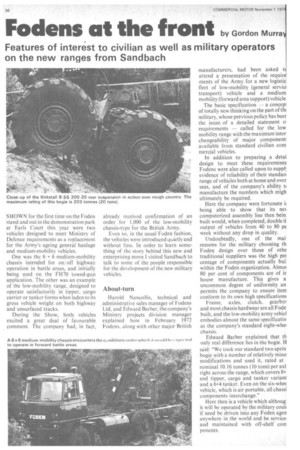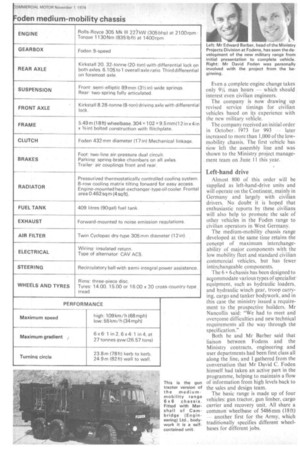Fodens at the front by Gordon Murra
Page 40

Page 41

Page 42

If you've noticed an error in this article please click here to report it so we can fix it.
Features of interest to civilian as well as military operators on the new ranges from Sandbach
SHOWN for the first time on the Foden stand and out in the demonstration park at Earls Court this year were two vehicles designed to meet Ministry of Defence requirements as a replacement for the Army's ageing general haulage and medium-mobility vehicles.
One was the 6 x 6 medium-mobility chassis intended for on off highway operation in battle areas, and initially being used on the FH70 towed-gun application. The other was an example of the low-mobility range, designed to operate satisfactorily in tipper, cargo carrier or tanker forms when laden to its gross vehicle weight on both highway and unsurfaced tracks.
During the Show, both vehicles excited a great deal of favourable comment. The company had, in fact, already received confirmation of an order for 1,000 of the low-mobility chassis-type for the British Army.
Even so, in the usual Foden fashion, the vehicles were introduced quietly and without fuss. In order to learn something of the story behind this new and enterprising move I visited Sandbach to talk to some of the people responsible for the development of the new military vehicles.
About-turn
Harold Na ncol lis, technical and administrative sales manager of Fodens Ltd, and Edward Barber, the company's Ministry projects division manager explained how in February 1972 Fodens, along with other major British
manufacturers, had been asked t attend a presentation of the requir ments of the Army for a new logisti fleet of low-mobility (general servict transport) vehicle and a medium mobility (forward area support) vehicle The basic specification -a concep of totally new thinking on the part of th military, whose previous policy has beer the issue of a detailed statement o requirements called for the low mobility range with the maximum inter changeability of major component: available from standard civilian corn mercial vehicles.
In addition to preparing a detai design to meet these requirements Fodens were also called upon to suppl: evidence of reliability of their standar( range of vehicles both at home and over seas, and of the company's ability tt manufacture the numbers which migh ultimately be required.
Here the company were fortunate il being able to show that its neN
computerized assembly line then bein, built would, when completed, double it output of vehicles from 40 to 80 pe week without any drop in quality.
Undoubtedly, one of the mai. reasons for the military choosing th
Foden design over those of othe traditional suppliers was the high pet centage of components actually buil within the Foden organization. Almof.
80 per cent of components are of ir house manufacture. This gives a uncommon degree of uniformity an permits the company to ensure item conform to its own high specifications Frame, axles, clutch. gearbo) and most chassis hardwear are all Fode built, and the low-mobility army vehicl embodies almost the same specificatio as the company's standard eight-whet chassis.
Edward Barber explained that th only real difference lies in the bogie. H said: "We took our standard two sprin bogie with a number of relatively mino modifications and used it, rated at nominal 10.16 tonnes (10 tons) per axl right across the range, which covers 8x end tipper, cargo and tanker variant and a 6x4 tanker. Even on the six-whet vehicle, which is air portable, all chassi components interchange."
Here then is a vehicle which althougl it will be operated by the military couli
if need he driven into any Foden agen anywhere in the world and be service, and maintained with off-shelf corn ponents.
Even a complete engine change takes only 91/4 man hours — which should interest even civilian engineers.
The company is now drawing up revised service timings for civilian vehicles based on its experience with the new military vehicle.
The company received an initial order in October. 1973 for 993 later increased to more than 1,0.00 of the lowmobility chassis. The first vehicle has tow left the assembly line and was shown to the Ministry project management team on June 11 this year.
Left-hand drive
Almost 800 of this order will be supplied as left-hand-drive units and will operate on the Continent; mainly in Germany and largely with civilian drivers. No doubt it is hoped that enthusiastic reports by these civilians will also help to promote the sale of other vehicles in the Foden range to civilian operators in West Germany, The medium-mobility chassis range developed at the same time retains the concept of maximum interchangeability of major components with the low mobility fleet and standard civilian commercial vehicles, but has fewer interchangeable components.
The 6 x 6,chassis has been designed to acpmmodate various types of specialist equipment, such as hydraulic loaders, and hydraulic winch gear, troop carrying, cargo and tanker bodywork, and in this ease the ministry issued a requirement to the prospective builders, Mr Nancollis said: "We had to meet and overcome difficulties and new technical requirements all the way through the specification." Both he and Mr Barber said that liaison between Fodens and the Ministry contracts, engineering and user departments had been first class all along the line; and I gathered from the conversation that Mr David C. Foden himself had taken an active part in the programme, helping to maintain a flow of information from high levels back to the sales and design team.
The basic range is made up of four vehicles: gun tractor, gun limber, cargo carrier and recovery unit. All share a common wheelbase of 5486 mm (18ft) another first for the Army, which traditionally specifies different wheelbases for different jobs. The basis of the vehicle's on/ off road performance, is its high articulation reacting bogie. Of Kirkstall design, the bogie nevertheless incorporates some Foden manufactured parts, including the main frame bracket.
The design is such that spherical seats in the spring location brackets restrain the axle in the vertical and horizontal position, leaving the springs free from twisting loads irrespective of axle position. Hefty torque rods transfer braking/ acceleration stresses to the chassis while maintaining optimum propshaft angles and axle alignment during articulation. This bogie is rated for a maximum 20,320 tonnes (20 tons) with a ground clearance of 457 mm (18 ins). The front steering axle, also a Kirkstall design, rated at 8.138 tonnes (8 tons), is a spiral bevel unit with differential lock.
Undoubtedly, the engineering facilities at Fodens, which include an iron foundry, helped to cut down the time taken to build the prototype vehicle. A case in point is the auxiliary gearbox, which is a two-speed, threeshaft, constant-mesh helical unit with disengageable front-wheel drive.
This unit is rated at a maximum input torque of 9500Nm (7000 lhft) and as no suitable unit was available in the UK it is a purpose-designed unit, again from Kirkstall. Outside suppliers were talk
ing about a delivery time of 14 months just for the supply of castings. However, by using in-house production at Fodens design was finalized and the box built in just seven months.
Now the company is in the somewhat amusing position of being a subcontractor to one of its own subcontractors, but at least the job gets done.
This same transfer box also has a road speed-sensing device which synchronizes its pto output with that of the main drive-line for operation with hydrostatic and mechanically driven trailers.
By using a common wheelbase for the range Fodens have been able to arrange that all chassis mounted units are in the same place for ease of maintenance and if necessary cannibalization. Army REME teams visited the works to advise on the layout and design of components and the complete vehicle. Several modifications were made as a,result of their suggestions.
Driver environment and maintenance accessibility have been successfully combined by fitting the Foden S90 all-steel cab, and for the first time the comfort, low noise level and ease of control now associated with civilian trucks is available in a military vehicle. The cab tilts to an angle of 45° for normal servicing and can be made to tilt up to 65° for engine removal. In the case of major overhauls the cab layout has been designed to allow complete removal in the minimum time by providing quickly detachable, multipoint electrical connections and by grouping the remaining pneumatic and hydraulic connections in easily accessible areas.
Bodywork on the medium ranges will be supplied by Marshall of Cambridge (Engineering) Ltd.
The first examples of the mediummobility vehicle built up as gun tractors will soon be taking part in multinational gun trials in competition with vehicles from Fiat and Mercedes-Benz, but Fodens are more than optimistic of their performance.
Mr Nancollis said: "The Foder 6x6 is the only vehicle which has been designed to meet all basic requirements of the job; it is a self-contained unit which carries gunners, shells and stores in addition to towing the gun itself."
Undoubtedly, there will also be civilian spin-offs from these new and advanced military vehicles. The positioning of the cab and major components and the 5.48m (18ft) wheelbase of the 6x6 gun tractor will allow it to carry a 6m (20 ft) ISO container. This opens up obvious future uses for this vehicle should it ever be made available to civilian operators.






























































































